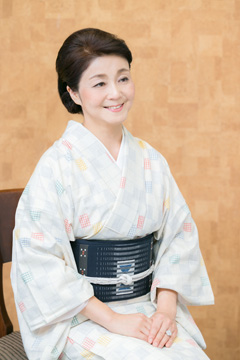“The Heart of Japan That I Want to Convey”
As a first step toward helping readers to get to know the Japanese spirit, I have selected and illustrated 10 tales from among the many fables, legends, and biographies of great people passed down in Japan from generation to generation since ancient times. In Japan, people become familiar with these stories as part of their home education—classic stories told by strict grandparents, picture books read to them as they sit on a parent’s knees, popular radio and television programs, movies, and so on. They represent the background of the Japanese spirit and are often quoted, albeit in a different form, in Japan’s internationally acclaimed anime and manga. I hope that these stories, and my accompanying Japanese-style illustrations, with their unique tones and sober colors of natural mineral pigments, help to stimulate interest in Japan.
Illustrations and text: Mami Nakamura
Click on a story to jump to it.
3. The Giant Eight-Headed, Eight-Tailed Snake
4. Battles of Kawanakajima: Kenshin and Shingen
5. Kobayashi Torasaburo and the Spirit of “One Hundred Bags of Rice”
6. Honda Tadatomo and the San Francisco
7. Tachibana Akemi’s Dokugakugin
8. Princess Oto-Tachibana’s Sacrifice for Her Husband
1. The Wise Young Monk
Once upon a time, there was a witty and popular young monk called Ikkyu. One day, a lord who had heard about him invited Ikkyu to his castle. “I have a favor to ask of you,” the lord said. “The tiger in this screen painting keeps coming out of the picture and doing bad things. I want you to tie him up or something.” “That must be awful for you,” Ikkyu replied. “Just leave it to me.” Putting on a headband and rolling up his sleeves, Ikkyu took a rope and stood in front of the screen. “I’m ready,” he said. “Drive the tiger out of the screen!” “What are you talking about?” the lord blurted out. “There’s no way I can drive the tiger out of the screen.” Ikkyu smiled and said, “What a pity. I mean, there’s no way I can tie up the tiger if it doesn’t come out.” With this, Ikkyu sat down again, righted his posture, and slowly and courteously bowed. Seeing this, the lord laughed loudly. “Well done, young monk,” he said. “You win!” Ikkyu returned to his temple with lots of bounty.
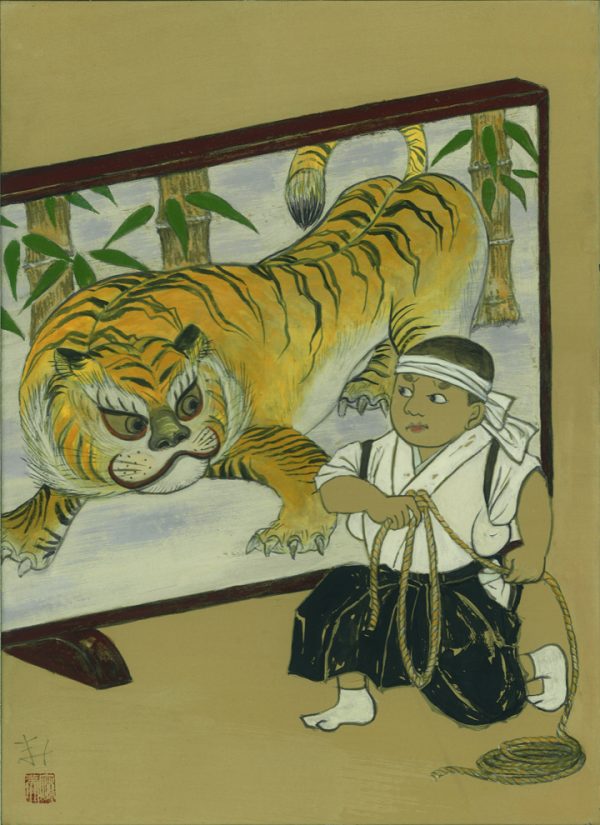
Nakamura: This is a well-known story about the beloved and witty young monk Ikkyu (1394–1481), who has featured in TV cartoons broadcast around the world. As well as China, Hong Kong, Taiwan, Thailand, Myanmar, Malaysia, and Indonesia, they have been aired in Hawaii and Italy as well and apparently have been extremely popular. These witty stories, in which Ikkyu thinks quickly to deal with outrageous demands, end with a laugh. In this sense, they fall into the same category as rakugo, a Japanese comic monologue. In painting the illustration, I imagined a kind of interplay going on between the fierce but somehow rather cute tiger and Ikkyu.
2. Lesson of the Three Arrows
Mori Motonari (1497–1571), a local lord in the Sengoku, or Warring States, period controlling a region in western Honshu, had three sons. One day Motonari called his three sons, gave them one arrow apiece, and told them to break the arrows. They snapped the arrows without any trouble. Motonari then gave them a bundle of three arrows and told them to break the bundles. However much they tried, the sons could not break the bundles of arrows. “You see,” Motonari said to them. “Even when the arrows are thin, if they stick together, they become that much stronger. So, if the three of you combine your strength and defend the province, you won’t be defeated by any enemy.” The sons did not forget their father’s words and came together to face up to difficulties. As a result, the Mori clan prospered for a long time.
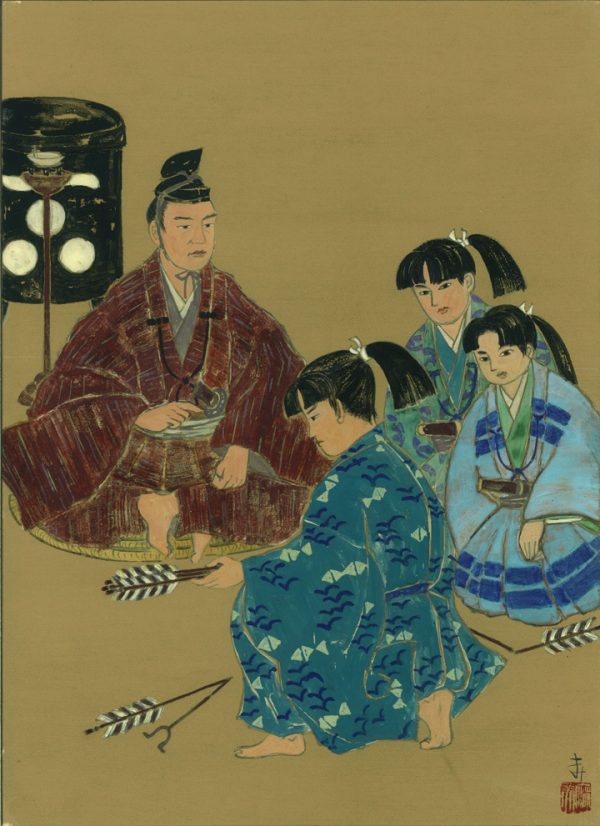
Nakamura: There are similar anecdotes to the lesson of the three arrows around the world. The original is thought to have been The Bundle of Sticks in Aesop’s Fables, written in Greece around the sixth century BC. Other examples include a classical tale of China and the lesson given by his mother when Genghis Khan, who went on to establish the Mongol Empire, fought with his brothers. It is fascinating to wonder whether this common legend around the world results from pure coincidence or transmission.
3. The Giant Eight-Headed, Eight-Tailed Snake
When Susanoo no Mikoto, a deity in Japanese mythology, was walking in Izumo Province (now Shimane Prefecture), he came across an elderly couple crying together with their daughter. The elderly couple told him they were crying because their daughter, Kushinada-hime, was going to be eaten by a fearsome snakelike monster with eight heads and eight tails. “I am the younger brother of the sun goddess Amaterasu Omikami,” Susanoo no Mikoto told them. “If you offer your daughter to me, I will save her.” The elderly couple happily agreed. Susanoo no Mikoto then prepared eight pots of sake and waited for the giant snake to come.
After a while, the giant snake appeared, drank the pots of sake, and, inebriated, fell asleep. Waiting for this moment, Susanoo no Mikoto took his sword and slayed the snake, cutting it into pieces. Susanoo no Mikoto then presented a splendid sword that had come out of the giant snake’s severed tail to Amaterasu Omikami. Later this sacred sword, called the Kusanagi no Tsurugi, became one of the three imperial regalia handed down in the imperial household.

Nakamura: There is a similar story in Grimms’ Fairy Tales, so this picture was chosen for the cover of the German edition of my book. The story in Grimms’ Fairy Tales involves the slaying of a dragon with seven heads. (The image imparted by such myths and legends deserves attention. For example, in the West the dragon is a symbol of destruction and wickedness, but in the East it symbolizes productivity and bountiful harvests. In the story about the eight-headed and eight-tailed snake, it is interesting that the slain monster begets a sacred sword.) It is rather exciting to think that while myths and legends pass on psychological messages unique to local customs to future generations, one can spot commonalities among countries.
4. Battles of Kawanakajima: Kenshin and Shingen
In the Sengoku, or Warring States, period, Kawanakajima in Shinano Province (now Nagano Prefecture) was the site of several battles between the armies of Uesugi Kenshin (1530–78), who controlled Echigo Province (now Niigata Prefecture), and Takeda Shingen (1521–73), who controlled Kai Province (now Yamanashi Prefecture). In the fourth battle, just before dawn, the Uesugi banner appeared through the misty light. It had been a very foggy night, and Shingen had carelessly thought that the enemy would not attack until morning. As the two armies clashed, Shingen received reports one after the other that his soldiers were being slain. Unmoved, Shingen began working out a tactic by himself. Then, suddenly, Kenshin alone came dashing up to Shingen’s headquarters, wielding his sword at Shingen and crying, “Prepare to die!” Shingen defended himself with his iron military leader’s fan. The two warlords glared at each other, but in the end there was no decisive outcome.
After this battle, the Imagawa clan of Suruga Province (now Shizuoka Prefecture) and the Hojo clan of Odawara Province (now Kanagawa Prefecture) plotted not to sell salt to Kai, which was inland and surrounded by mountains (and therefore did not have access to salt). Hearing this, Kenshin boldly sent salt to Shingen, his archrival. “Battles are decided by bows and arrows,” Kenshin said. “Making the enemy suffer through lack of salt is the height of cowardice and indecency.” Shingen was happy to receive Echigo’s salt.
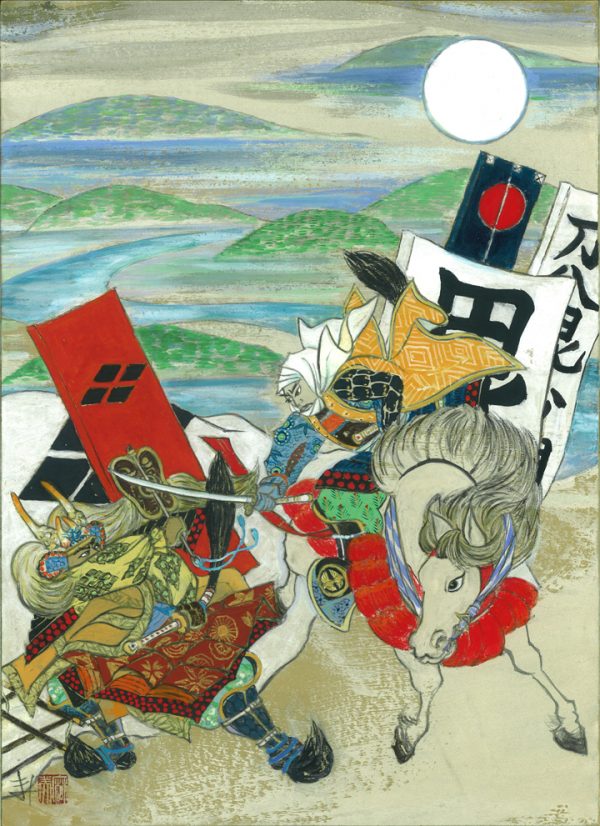
Nakamura: This is a moving tale about Uesugi Kenshin, one of the most beloved warlords of the Sengoku period. The story about sending salt to your enemy is necessary in present times more than ever before. Kasugayama Castle in Joetsu, Niigata Prefecture, which was Kenshin’s residential castle, is a mountain fortress. It is now a popular historical spot. As they climb up to it, visitors can ponder the meaning of human righteousness. The bronze statue of Kenshin, gazing down on the world below, is famous too.
5. Kobayashi Torasaburo and the Spirit of "One Hundred Bags of Rice"
In 1868 Japan embarked on the transformation from a feudal samurai-led society to a modern Western-style state. In the process, the Nagaoka domain (now Niigata Prefecture), which was defeated in battle by the new government army, was laid to waste. The people there had nothing to eat. Recognizing their plight, the Mineyama domain, a related branch, sent 100 bags of rice as a token of sympathy. (One bag contained about 60 kg of rice.) The Nagaoka domain’s samurai rejoiced at the thought that the rice would be distributed. But Kobayashi Torasaburo (1828–77), the grand counselor of the domain, had other ideas. “If the bags of rice, even 100 of them, are eaten,” he said, “they will be gone in no time. But if we invest them in education, they will be worth 10,000 bags or one million bags in the future. The prosperity of our domain and towns depend on people. Now is the time to build a school and foster human resources.” The samurai protested, but Torasaburo, staking his life on the cause, managed to persuade them.
So the 100 bags of rice were sold, and Kokkan Gakko school was built with the proceeds. Not only the children of samurai but also the kids of farmers and townsfolk were permitted to enter, and the school went on to turn out many talented students.
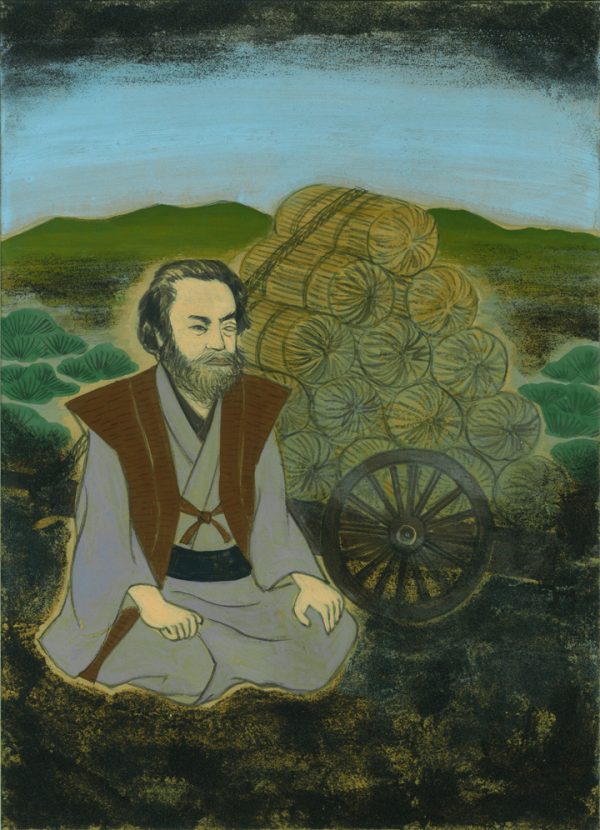
Nakamura: In the fall of every year the city of Nagaoka in Niigata Prefecture holds the Kome Happyo Festival (Hundred Bags of Rice Festival) to encourage people to think about the future rather than immediate concerns. Even today, the descendant lords (present heads) of the Mineyama domain and Nagaoka domain are on good terms and parade side by side in the festival’s samurai procession. The sight of people cooperating and enlivening the festival makes one think of the future spawned by 100 bags of rice.
6. Honda Tadatomo and the San Francisco
This is a story about Honda Tadatomo (1582–1615), the lord of Otaki Castle in Kazusa Province (now Chiba Prefecture). In 1609 the San Francisco, a Spanish ship heading from the Philippines to Mexico, hit a storm and ran aground off the Boso Peninsula. Spotting the shipwreck, village folk earnestly engaged in rescue activities, as a result of which Rodrigo de Vivero (1564–1636), the governor of the Philippines, and 317 crew members survived. Despite the differences in skin color and language (foreigners were called “aliens” at that time), Tadatomo, the lord of the castle, looked after them generously and ordered that they be respected as guests. Even in that age of national isolation, Tadatomo recognized not only the preciousness of human life but also the importance of exchange with other countries.
Under the protection of Tadatomo, Rodrigo also had an audience with the shogun, Tokugawa Ieyasu. Eventually Rodrigo managed to return home aboard a ship built under Ieyasu’s orders by Miura Anjin (the Japanese name of the English mariner William Adams, 1564–1620, who served as a diplomatic adviser to Ieyasu in the early Edo period). It is said that Rodrigo and the crew were full of gratitude for the warmheartedness of the Japanese at that time.
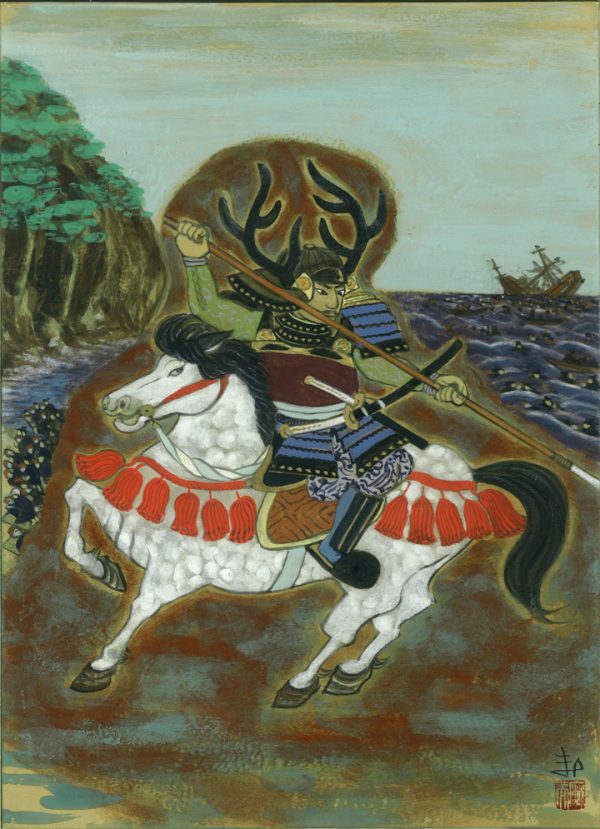
Nakamura: In 1888 Japan and Mexico concluded an amity, commerce, and navigation treaty. It was Japan’s first treaty with a non-Asian country that was not “unequal.” In the background, the story of Japan’s rescue of the San Francisco crew is said to have been a contributing factor. Subsequently as well, Japan and Mexico have built close bonds and friendly ties.
7. Tachibana Akemi's Dokugakugin
Dokugakugin (Reciting Poetry for My Own Pleasure) is a collection of linked poems written by Tachibana Akemi (1812–68), a poet of the Fukui domain in Echizen Province (now Fukui Prefecture). In these poems, Akemi evoked mild emotions by describing the joys and delights of casual events in his daily life, albeit a poor one. Matsudaira Shungaku, the lord of the Fukui domain, regarded Akemi’s talent highly and engaged in an exceptional exchange with him transcending the strict class system of the time. Among other things, Shungaku granted a rice stipend to Akemi, ordered him to select outstanding poems in the Manyoshu (the earliest extant collection of Japanese poems), and visited his dwelling.
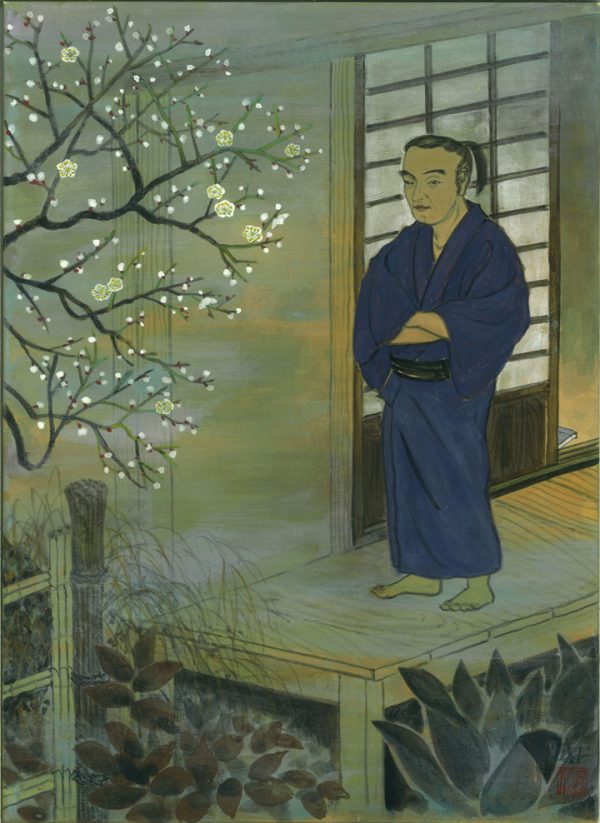
Nakamura: The above poem, one of the most representative in Dokugakugin, was quoted by US President Bill Clinton in a welcome speech when then Emperor Akihito and Empress Michiko visited the United States in 1994. That event rekindled interest in Japan as well. Through the poem, President Clinton was praising the affluent mind of the Japanese. All the poems in Dokugakugin begin with “It is a pleasure when . . .” The poems teach us that as long as we have the will to pursue “pleasure” at all times, we can lead affluent lives.
8. Princess Oto-Tachibana's Sacrifice for Her Husband
This is the legend of Princess Oto-Tachibana, the wife of Prince Yamatotakeru. On a mission to subjugate an aboriginal tribe, Prince Yamatotakeru and his retinue were sailing from Sagami Province (now Kanagawa Prefecture) to Kazusa Province (now Chiba Prefecture) when a storm hit them. Their boats looked like capsizing at any moment. Princess Oto-Tachibana wanted to protect her husband, who had been delegated an important mission, at all costs, so she flung herself into the raging sea in an attempt to pacify the angry sea god. The high waves immediately subsided, and the boats managed to reach Awa Province (now Chiba Prefecture). Before jumping into the sea, Princess Oto-Tachibana wrote a poem of gratitude:
You my Lord who at that time
in the middle of the raging fires
showed such thought for my safety
In the poem, Princess Oto-Tachibana recalled how, when they were surrounded by fire in Suruga Province (now Shizuoka Prefecture), Prince Yamatotakeru had risked his life to protect her and continued to shower her with words of encouragement.
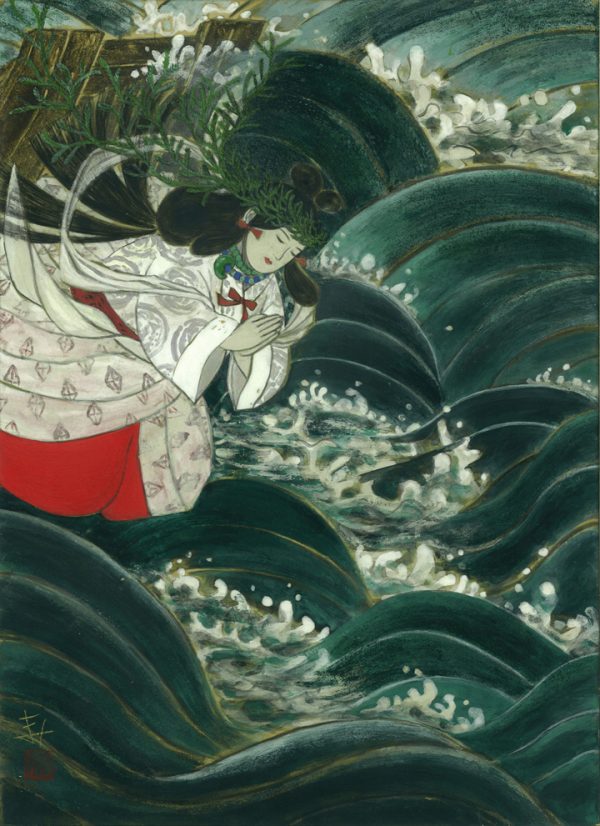
Nakamura: In a keynote speech delivered at a congress of the International Board on Books for Young People (IBBY) in New Delhi in 1998, then Empress Michiko shared her memories of reading in her childhood days with an international audience. Referring to the legend of Princess Oto-Tachibana, Empress Michiko said, “I got the perception that love and sacrifice were not simply very close but rather were inseparable.” In Chiba Prefecture there are place names associated with the legend, including Kisarazu, which in Japanese sounds phonetically like the words for “I can’t leave you” (grieving over his wife’s fate, Prince Yamatotakeru found it hard to depart from this area), and Sodegaura (from the myth that Princess Oto-Tachibana’s sleeves [sode] washed ashore there). This legend has been passed down from generation to generation as a love story linking past and present.
9. Morning Glories in the Well Bucket
There was a young girl named Chiyo living in Matsuto in Kaga Province (now Ishikawa Prefecture). One morning Chiyo went to the well to get some water, but morning glories were entangled in the bucket. Thinking what a pity it would be to remove the vines, Chiyo gave up drawing from the well and asked a neighbor to share some water. Then she composed a haiku expressing her feelings:
Morning glories
entangled in the bucket at the well
so, I beg for water
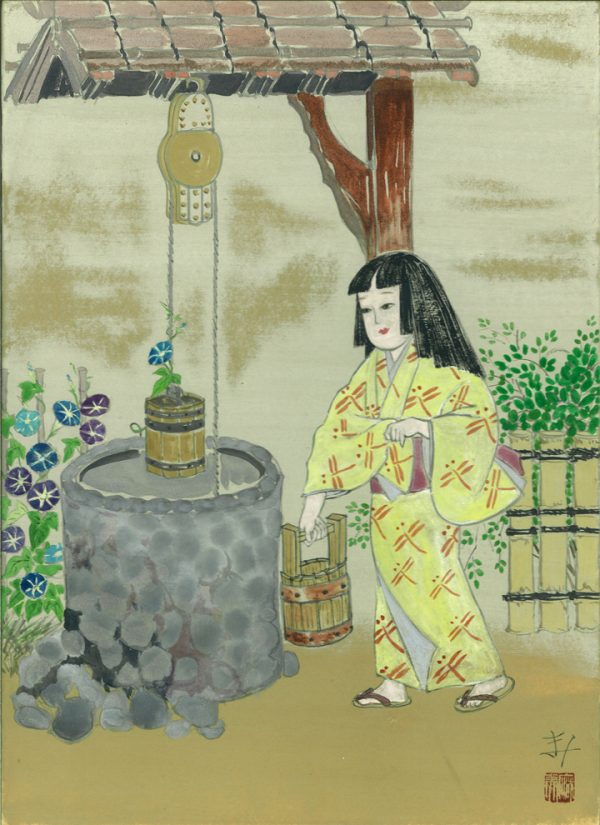
Nakamura: After the British poet Edwin Arnold composed a poem with a free translation of this haiku in 1894, it was taken up frequently in various countries in books and other media introducing Japan. Even today I hear that the haiku is fondly recited overseas, and it has been taken up in a US textbook as well. Chiyo’s haiku, which expresses the gentleness of the Japanese and captures a simple treasured moment in the daily life of common folk, is loved by poets around the world.
10. White Chrysanthemum Fireworks of Nagaoka
On August 1, 1945, near the end of World War II, the city of Nagaoka in Niigata Prefecture was reduced to ashes by a US air raid, and many lives were lost. Now, every year in Nagaoka, at the start of a major fireworks display on August 1 (the day of the air raid), 2, and 3, white fireworks in the shape of a large chrysanthemum, dubbed the “White Chrysanthemum” fireworks, are launched into the sky in memory of those who died.
In 1990 the pyrotechnician Seiji Kase launched 3,000 fireworks in Khabarovsk, Russia. Captured during the war and interned in Siberia, Kase wanted to console the souls of fellow soldiers who had died there. Full of emotion, what he chose for that occasion was the White Chrysanthemum display. On the following day, Kase visited the cemeteries of both Japanese and Soviet soldiers. “Having paid my respects at the cemeteries without distinguishing between friend and foe,” he said, “I feel as if a huge weight has been lifted off my chest.”
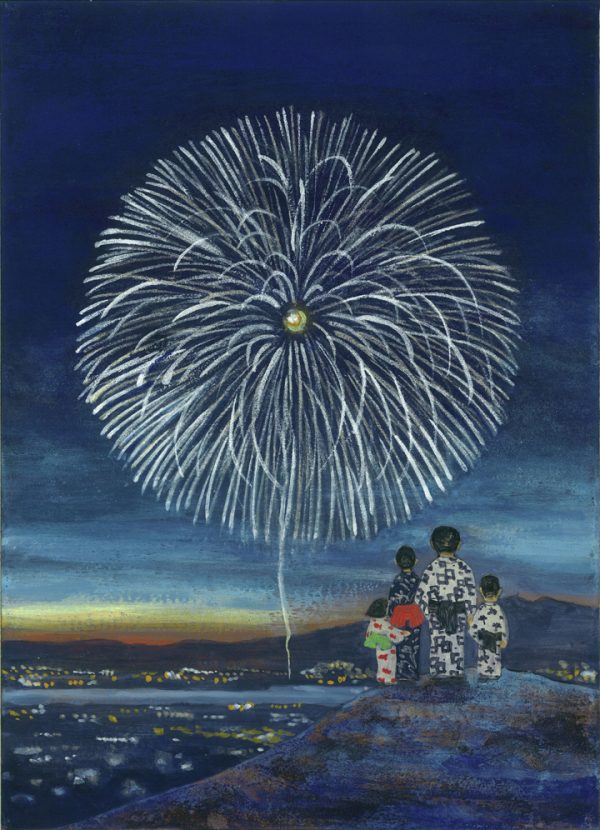
Nakamura: On August 15, 2015, the seventieth anniversary of the end of World War II, the White Chrysanthemum fireworks were launched at Pearl Harbor in Honolulu. They are also launched in Nagaoka every year on December 8, the anniversary of the beginning of the war between Japan and the United States. The White Chrysanthemum fireworks continue to transmit the Japanese people’s prayer for world peace to people around the globe.
Profile of Mami Nakamura
Painter and illustrator. Researched the spirituality of the Japanese through the method of depth psychology, studied painting at an art school, and aspires to convey the soul of the Japanese through the medium of paintings. Has drawn illustrations of historical items, samurai, business founders, and so on for magazines, newspapers, television programs, and other media. Worked as an NHK satellite broadcast newscaster and was awarded the 1986 Miss Japan Grand Prix. Since 2007 has been involved in the planning, illustrations, and text for the cover of the Budo (Martial Arts) magazine published by Nippon Budokan. In this series on the theme of “The heart of Japan that I want to convey,” she draws illustrations conveying the spiritual traditions of the Japanese. Nakamura holds exhibitions and lectures around Japan to arouse, through her works, a spirit of righteousness with which everyone can empathize, putting special effort into reaching out to the young generation. She has published Tsutaetai Nippon no kokoro (The Japanese Mind We Wish to Share; Nippon Budokan); the German edition, titled Von Amaterasu bis Olympia, was issued in 2020.
Mami Nakamura’s official website: https://maminoe.jp/en/
Profile of Mami Nakamura
Painter and illustrator. Researched the spirituality of the Japanese through the method of depth psychology, studied painting at an art school, and aspires to convey the soul of the Japanese through the medium of paintings. Has drawn illustrations of historical items, samurai, business founders, and so on for magazines, newspapers, television programs, and other media. Worked as an NHK satellite broadcast newscaster and was awarded the 1986 Miss Japan Grand Prix. Since 2007 has been involved in the planning, illustrations, and text for the cover of the Budo (Martial Arts) magazine published by Nippon Budokan. In this series on the theme of “The heart of Japan that I want to convey,” she draws illustrations conveying the spiritual traditions of the Japanese. Nakamura holds exhibitions and lectures around Japan to arouse, through her works, a spirit of righteousness with which everyone can empathize, putting special effort into reaching out to the young generation. She has published Tsutaetai Nippon no kokoro (The Japanese Mind We Wish to Share; Nippon Budokan); the German edition, titled Von Amaterasu bis Olympia (published by the Deutsch-Japanische Gesellschaft Trier e.V.), was issued in 2020.
Mami Nakamura’s official website: https://maminoe.jp/en/
